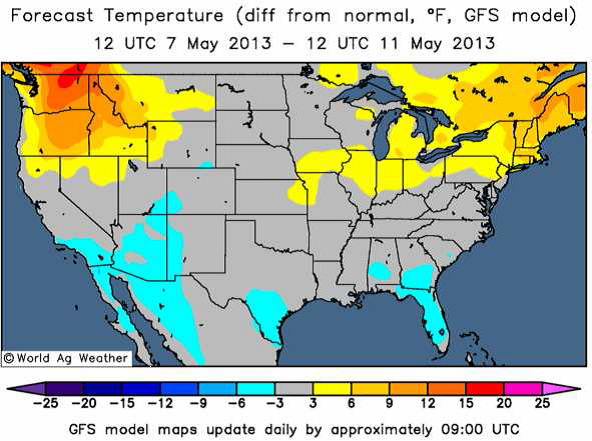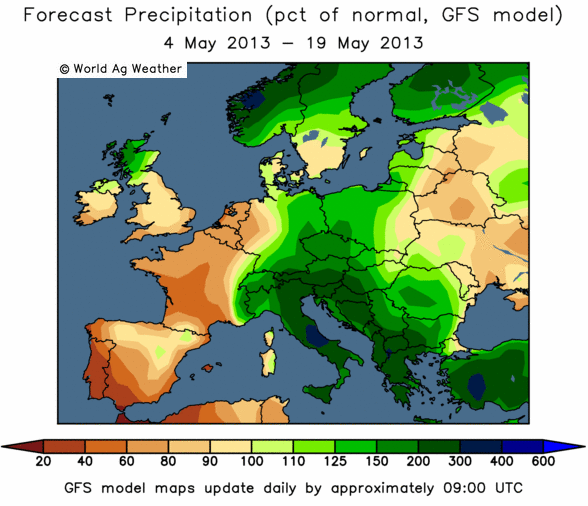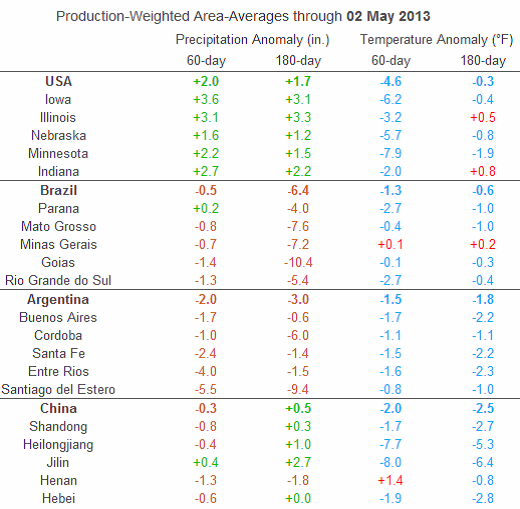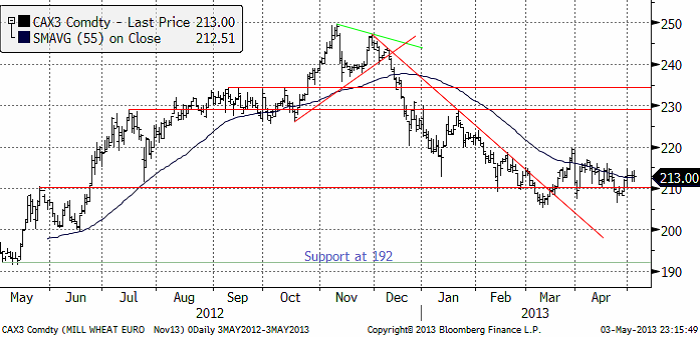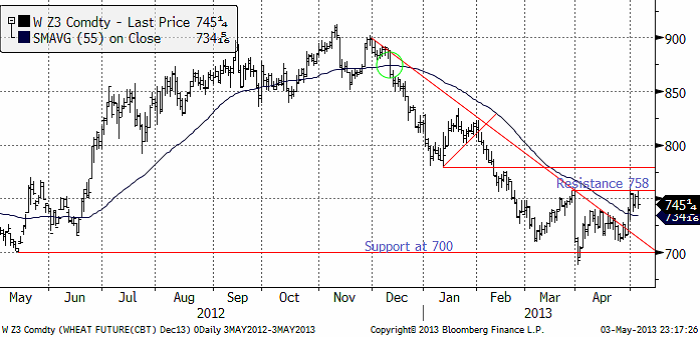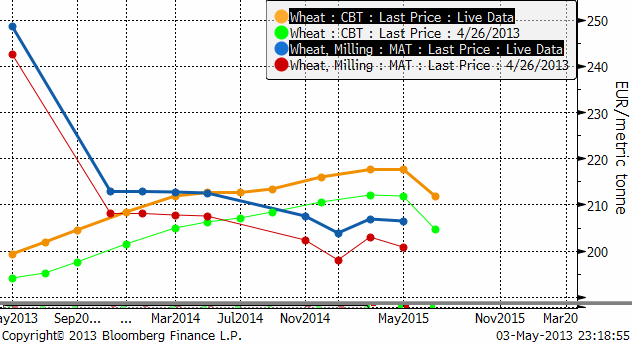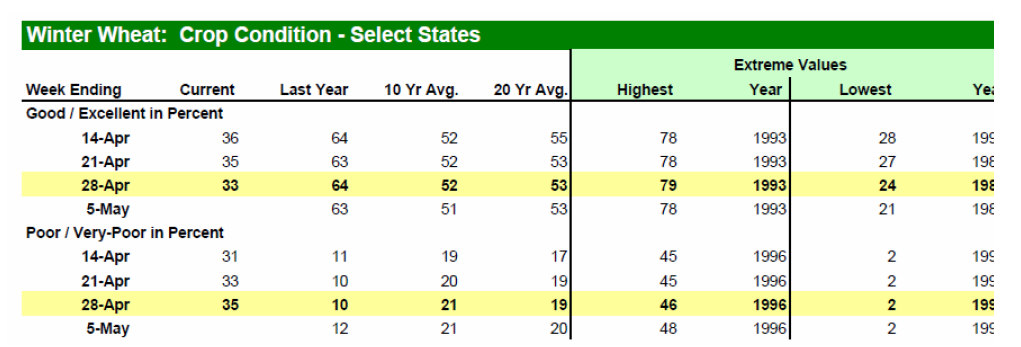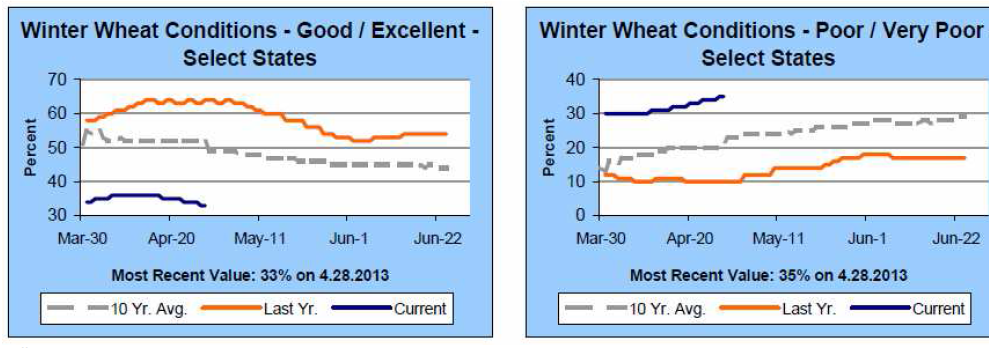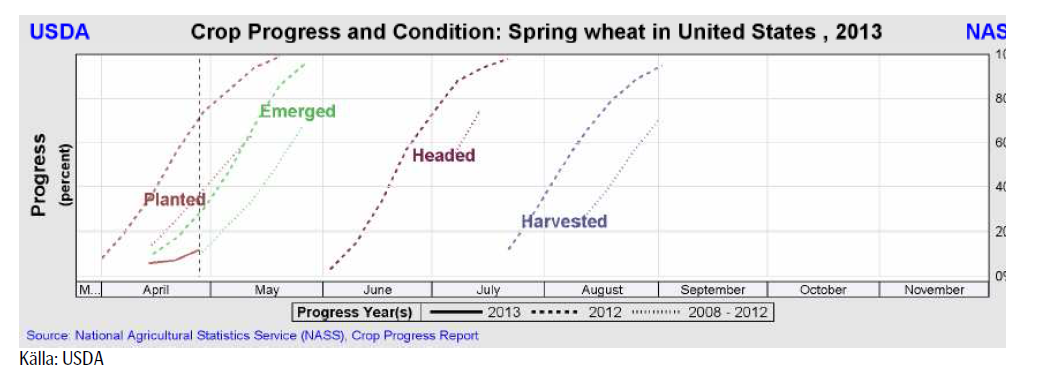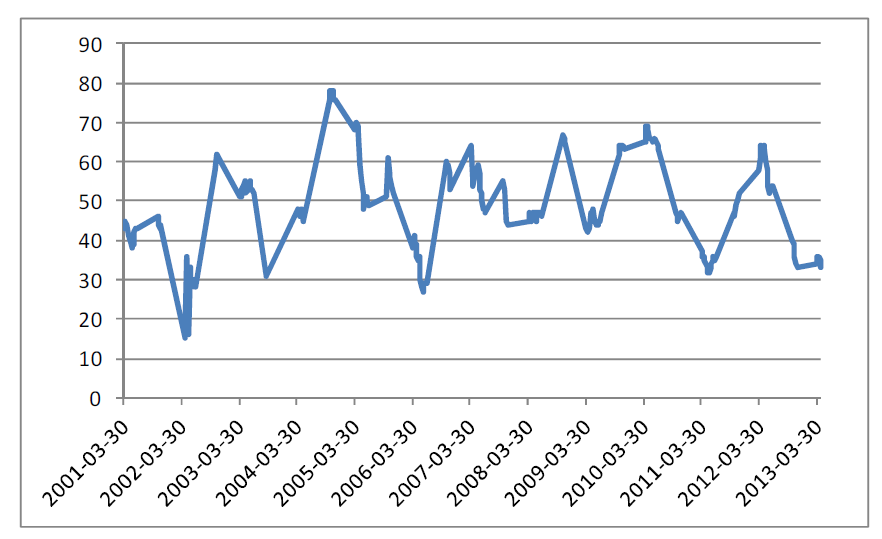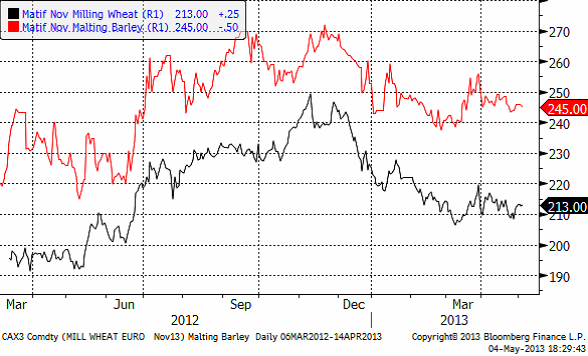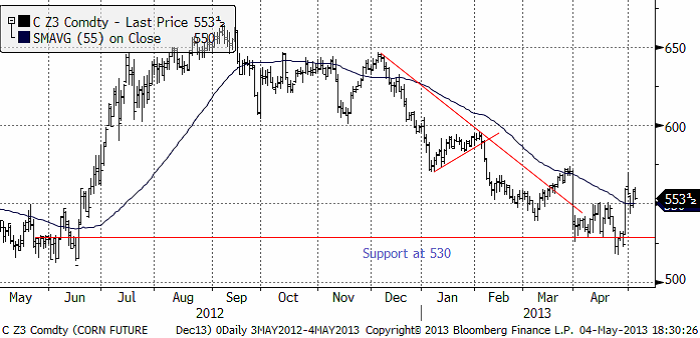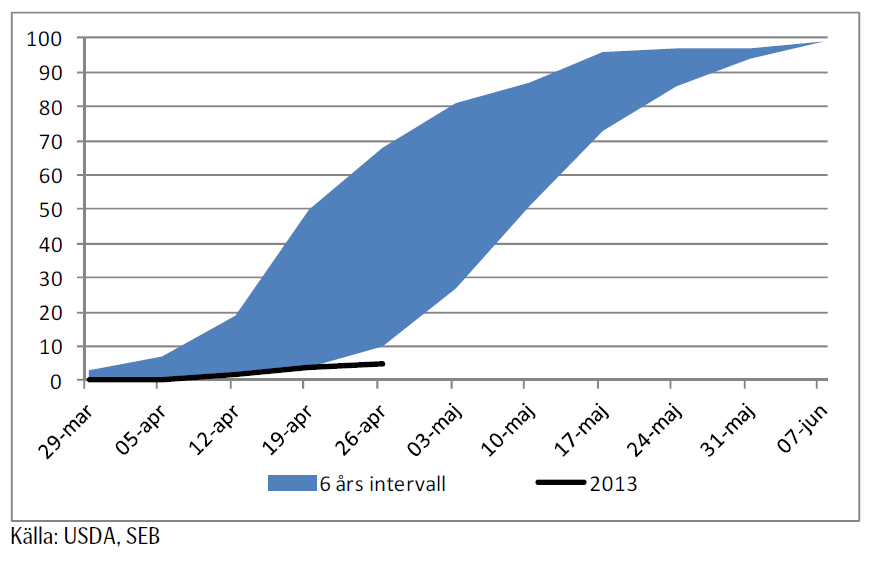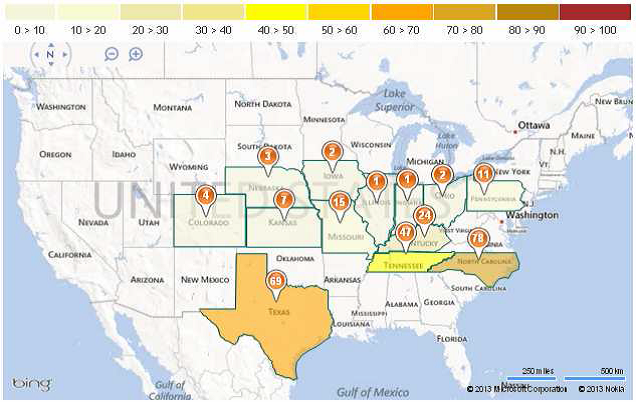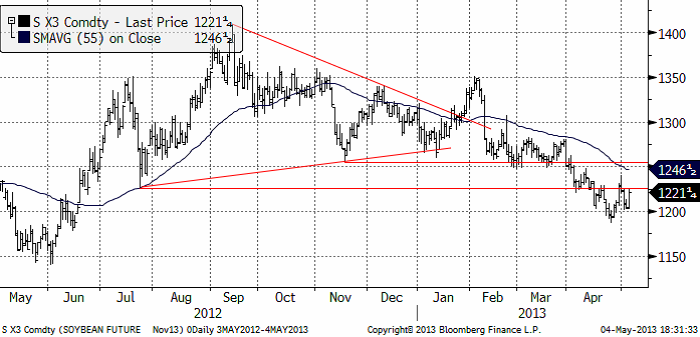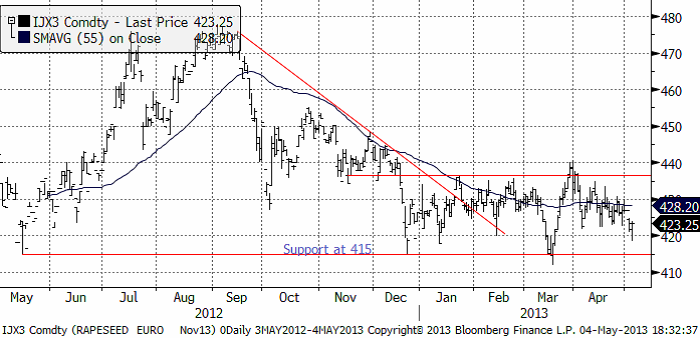Analys
SEB Jordbruksprodukter, 6 maj 2013
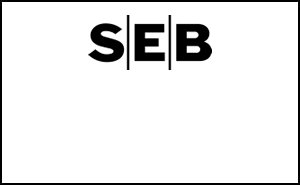
 USA var kallt och vått förra veckan, med frost och snö på många håll, ända nere i Texas. I torsdags fick norra Mellanvästern 35 cm snö. Höstvetets kondition försämrades i måndagens rapport från 35% ”good” och ”excellent condition” till 33% (redan innan förra veckans snö och frost). Sådden av majs ökade med bara 1% till veckan innan förra veckan, till rekordlåga 5%. Antagligen har väldigt lite blivit sått i veckan som gick. Det får vi facit på i kväll. Sojabönor har ännu inte kommit igång med sådden. Allt annat lika bör en allt för stor försening av majssådden leda till att sojabönor vinner areal.
USA var kallt och vått förra veckan, med frost och snö på många håll, ända nere i Texas. I torsdags fick norra Mellanvästern 35 cm snö. Höstvetets kondition försämrades i måndagens rapport från 35% ”good” och ”excellent condition” till 33% (redan innan förra veckans snö och frost). Sådden av majs ökade med bara 1% till veckan innan förra veckan, till rekordlåga 5%. Antagligen har väldigt lite blivit sått i veckan som gick. Det får vi facit på i kväll. Sojabönor har ännu inte kommit igång med sådden. Allt annat lika bör en allt för stor försening av majssådden leda till att sojabönor vinner areal.
 WASDE-rapporten kommer på fredag och nästa veckas brev kommer därför att innehålla en genomgång av den.
WASDE-rapporten kommer på fredag och nästa veckas brev kommer därför att innehålla en genomgång av den.
Den som vill lyssna på en tvåtimmars genomgång av WASDE-rapporten, och hur man analyserar marknaden samt placerar framgångsrikt i marknaden genom certifikat, är välkommen till ett seminarium hos SEB i Malmö.
Odlingsväder
USA var kallt och vått med frost och snö ända nere i Texas. 35 cm snö föll i torsdags över norra Mellanvästern. Kanada var varmare och torrare. I Europa var det lite nederbörd i norr, men desto mer på den södra halvan av kontinenten. Australien var huvudsakligen fortsatt torrt.
Nedan ser vi prognostiserad avvikelse från normal temperatur i USA.
Nedan ser vi prognostiserad avvikelse från normal nederbörd i Europa.
World Ag Weather publicerar även avvikelser från det normala för regn och temperatur för viktiga jordbruksområden. De har till och med bemödat sig om att vikta avvikelsen efter jordbruksareal. Vi ser att större delen av jorden är kallare än normalt. Vissa delar av Argentina har fått väsentligt mycket mindre nederbörd än normalt och USA tvärtom mycket mer än normalt.
Vi noterar också att Kina är väsentligt mycket kallare än normalt. Eventuella negativa effekter av det på väntad skörd har än så länge inte blivit kända.
Vete
Priset på november (2013) har stabiliserat sig över 210 euro per ton. Trenden är alltjämt nedåtriktad, men den här sidledes rörelsen är ändå ett observandum. Det är möjligt att pristrenden nedåt håller på att förlora momentum och att en prisuppgång kan ta vid. Det beror helt på vädret. Möjligen kan WASDE-rapporten på fredag bli utslagsgivande.
Decemberkontraktet på CBOT har stigit upp till motståndet på 758 cent per ton. Vi ser att det finns ytterligare ett motstånd på ca 780 cent, om 758 skulle brytas.
Ser vi på den senaste veckan förändring av terminskurvorna, ser vi att priserna gått upp både i Europa och i USA och ungefär lika mycket på alla löptider.
Nedan ser vi Crop condition från förra måndagens rapport.
Måndagens Crop Progress rapport från USDA visar att tillståndet för det amerikanska höstvetet är fortsatt dystert. 35% klassas nu som ”poor/very poor”, en ökning med 2% från veckan innan och att jämföra med 10% vid samma tid förra året. Höstvete klassat som ”good/excellent” har minskat med samma mängd och uppgår nu till 33%, vilket är den lägsta nivån sedan 1996, medan förra årets siffra vid samma tid låg på 64%. Dessutom har endast 14% av höstvetet gått i ax, vilket är långt efter förra årets 55% vid samma tid. I Kansas, den största producenten av HRW vete, backade höstvete i kategorin ”good/excellent” med 3% till 27%.
Det blöta och kalla vädret fortsätter också att försena de amerikanska lantbrukarnas sådd av vårvete. Endast 12% av sådden var avklarad per den 29 april, vilket är långt under det femåriga genomsnittet på 37%.
Crop condition för vintervetet i USA ligger kvar på den historiskt låga nivån, som vi ser i diagrammet nedan. Y-axeln visar hur många procent av arealen som har vete i ”good” eller ”excellent condition”.
The Kansas Crop Tour publicerade sin gissning på skörden; endast 313 mbu mot 383 mbu förra året.
Oklahoma Wheat Commission publicerade sitt estimat till 85 mbu mot 155 mbu förra året.
Vi fortsätter, med det observandum vi nämnt ovan, att tro på sidledes eller lägre priser. Uppgångar bör ses som tillfällen att sälja.
Maltkorn
Priset på maltkorn med leverans i november har ännu en vecka fortsatt att visa mer styrka än höstvetet / kvarnvetet på Matif.
Majs
Majspriset (december 2013) steg kraftigt när vädret slog och om det visade sig att sådden blivit ytterligare försenad. Priset har åtminstone kortsiktigt etablerat sig över 550 cent. Det KAN bli en trendvändning uppåt. Det återstår att se.
Sådden ligger kraftigt efter i USA. Nedan ser vi såddens framåtskridande i USA. 6-årsintervallet sträcker sig från 2007 till 2012.
Medelvärdet för de sex åren 2006 – 2012 är 33% klart. Den långsammaste starten var 2008, när 10% var sått. Nu är det alltså bara 5%, en marginell ökning från 4% en vecka tidigare men fortfarande långt under förra årets 49% vid den här tiden och även under det genomsnittet. Iowa, den största producenten, har nu påbörjat sådden men endast 2% är avklarad så här långt – att jämföra med det femåriga genomsnittet på 36%. Sådden av majs i de två andra stora producentstaterna, Illinois och Indiana, står fortfarande och stampar på 1% då kraftiga regnskurar i kombination med kallare väder än normalt har gjort att många fält fortfarande är alltför blöta.
Nedan ser vi en karta över staterna i ”Corn belt”, färgkodade efter hur många procent som är sått och med procentsiffran på kartan.
Det sägs att den 10 maj är en slags deadline för sådden. Den majs som sås efter det datumet ger lägre avkastning. Farmdoc har emellertid skrivit att även om skörden blir 14% mindre än den skulle blivit enligt den hektarskörd som man räknat med, kommer majsen att räcka till efterfrågan. En av de efterfrågeposter som ökat de senaste åren är efterfrågan till etanol. Den kommer inte att öka i år, eftersom USA redan nått maximal inblandning i bensinen av etanol. Foderefterfrågan kommer också att vara tämligen konstant. Med 14% lägre skörd räcker majsen till efterfrågan och ger en viss ökning av utgående lager, enligt Farmdoc. Det finns alltså en hel del marginal i den väntade skördens storlek.
Sojabönor
Sojabönorna (november 2013) anser jag befinner sig i negativ trend och vi ser en rekyl upp från 1200 cent. En rekyl är en naturlig och temporär fluktuation mot trenden.
Exporten från Brasilien börjar ta mer fart nu, efter de initiala problemen att få ut nästan 20 miljoner ton mer än förra året. Kinas tillväxt håller på att bromsa in. Nya svaga siffror kom i veckan. Den senaste köttskandalen där fårkött i egentligen kommit från flera andra djur. Det enda som stack ut med sin frånvaro av förklarliga skäl var hund. De här skandalerna och den allt jämt pågående nya fågelinfluensan gör att efterfrågan på soja borde vara dämpad framöver i Kina.
Man kan spekulera i att sojaarealen i USA borde bli större när den inte kan sås med majs. Arealen är antagligen inte utbytbar 1:1, inte minst pga behovet av utsäde. Marken är visserligen kvävegödslad sedan länge, men detta är en ”sunk cost” och även om det inte är till stor nytta för sojabönorna, så är det i vart fall inte till nackdel. Blir det fortsatt kallt drabbar vädret dock även sojaarealen.
Jag skulle passa på och sälja sojabönor på högre priser, eftersom trenden och fundamenta så väl pekar på lägre priser. Jag har svårt att se hur WASDE-rapporten kan bli positiv för marknaden
Raps
I flera veckor har vi noterat att rapspriset byggt upp fallhöjd i förhållande till det allt lägre sojabönspriset. I veckan som gick orkade inte rapsmarknaden hålla emot den kraften med fallande pris som följd. Den lilla nedgång som hittills ägt rum tror vi bara är början på en nedgång, som gör att priset på raps hamnar i paritet med sojapriset igen. Nedan ser vi november-terminens kursutveckling.
Skulle det tekniska stödet på 415 euro brytas, är detta en rejäl säljsignal. Om WASDE-rapporten är riktigt negativ för sojabönor skulle detta kunna inträffa. I mellantiden vill jag vara fortsatt såld raps.
[box]SEB Veckobrev Jordbruksprodukter är producerat av SEB Merchant Banking och publiceras i samarbete och med tillstånd på Råvarumarknaden.se[/box]
Disclaimer
The information in this document has been compiled by SEB Merchant Banking, a division within Skandinaviska Enskilda Banken AB (publ) (“SEB”).
Opinions contained in this report represent the bank’s present opinion only and are subject to change without notice. All information contained in this report has been compiled in good faith from sources believed to be reliable. However, no representation or warranty, expressed or implied, is made with respect to the completeness or accuracy of its contents and the information is not to be relied upon as authoritative. Anyone considering taking actions based upon the content of this document is urged to base his or her investment decisions upon such investigations as he or she deems necessary. This document is being provided as information only, and no specific actions are being solicited as a result of it; to the extent permitted by law, no liability whatsoever is accepted for any direct or consequential loss arising from use of this document or its contents.
About SEB
SEB is a public company incorporated in Stockholm, Sweden, with limited liability. It is a participant at major Nordic and other European Regulated Markets and Multilateral Trading Facilities (as well as some non-European equivalent markets) for trading in financial instruments, such as markets operated by NASDAQ OMX, NYSE Euronext, London Stock Exchange, Deutsche Börse, Swiss Exchanges, Turquoise and Chi-X. SEB is authorized and regulated by Finansinspektionen in Sweden; it is authorized and subject to limited regulation by the Financial Services Authority for the conduct of designated investment business in the UK, and is subject to the provisions of relevant regulators in all other jurisdictions where SEB conducts operations. SEB Merchant Banking. All rights reserved.
Analys
Tightening fundamentals – bullish inventories from DOE

The latest weekly report from the US DOE showed a substantial drawdown across key petroleum categories, adding more upside potential to the fundamental picture.

Commercial crude inventories (excl. SPR) fell by 5.8 million barrels, bringing total inventories down to 415.1 million barrels. Now sitting 11% below the five-year seasonal norm and placed in the lowest 2015-2022 range (see picture below).
Product inventories also tightened further last week. Gasoline inventories declined by 2.1 million barrels, with reductions seen in both finished gasoline and blending components. Current gasoline levels are about 3% below the five-year average for this time of year.
Among products, the most notable move came in diesel, where inventories dropped by almost 4.1 million barrels, deepening the deficit to around 20% below seasonal norms – continuing to underscore the persistent supply tightness in diesel markets.
The only area of inventory growth was in propane/propylene, which posted a significant 5.1-million-barrel build and now stands 9% above the five-year average.
Total commercial petroleum inventories (crude plus refined products) declined by 4.2 million barrels on the week, reinforcing the overall tightening of US crude and products.
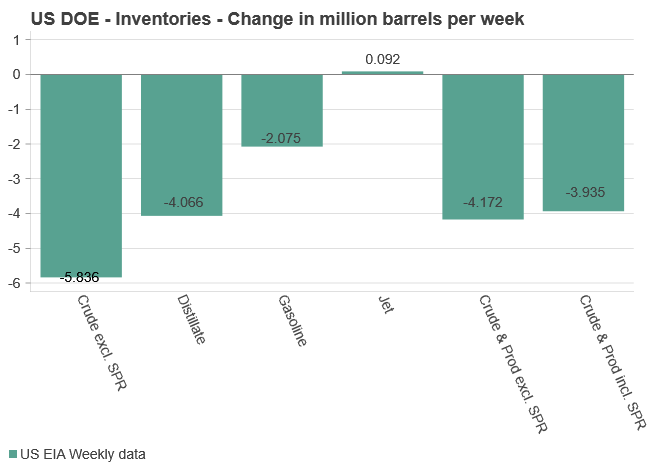
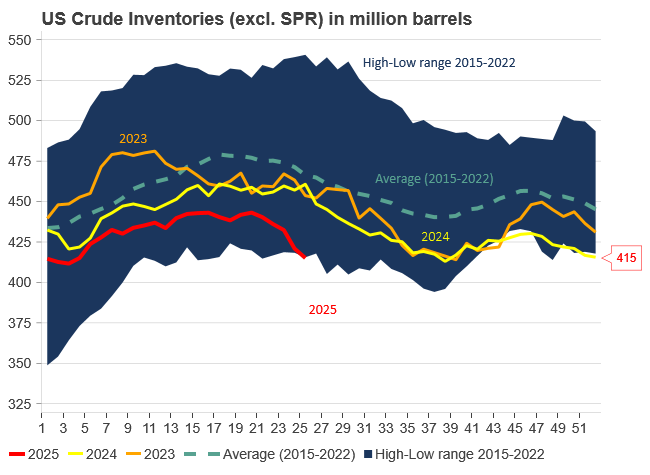
Analys
Bombs to ”ceasefire” in hours – Brent below $70

A classic case of “buy the rumor, sell the news” played out in oil markets, as Brent crude has dropped sharply – down nearly USD 10 per barrel since yesterday evening – following Iran’s retaliatory strike on a U.S. air base in Qatar. The immediate reaction was: “That was it?” The strike followed a carefully calibrated, non-escalatory playbook, avoiding direct threats to energy infrastructure or disruption of shipping through the Strait of Hormuz – thus calming worst-case fears.

After Monday morning’s sharp spike to USD 81.4 per barrel, triggered by the U.S. bombing of Iranian nuclear facilities, oil prices drifted sideways in anticipation of a potential Iranian response. That response came with advance warning and caused limited physical damage. Early this morning, both the U.S. President and Iranian state media announced a ceasefire, effectively placing a lid on the immediate conflict risk – at least for now.
As a result, Brent crude has now fallen by a total of USD 12 from Monday’s peak, currently trading around USD 69 per barrel.
Looking beyond geopolitics, the market will now shift its focus to the upcoming OPEC+ meeting in early July. Saudi Arabia’s decision to increase output earlier this year – despite falling prices – has drawn renewed attention considering recent developments. Some suggest this was a response to U.S. pressure to offset potential Iranian supply losses.
However, consensus is that the move was driven more by internal OPEC+ dynamics. After years of curbing production to support prices, Riyadh had grown frustrated with quota-busting by several members (notably Kazakhstan). With Saudi Arabia cutting up to 2 million barrels per day – roughly 2% of global supply – returns were diminishing, and the risk of losing market share was rising. The production increase is widely seen as an effort to reassert leadership and restore discipline within the group.
That said, the FT recently stated that, the Saudis remain wary of past missteps. In 2018, Riyadh ramped up output at Trump’s request ahead of Iran sanctions, only to see prices collapse when the U.S. granted broad waivers – triggering oversupply. Officials have reportedly made it clear they don’t intend to repeat that mistake.
The recent visit by President Trump to Saudi Arabia, which included agreements on AI, defense, and nuclear cooperation, suggests a broader strategic alignment. This has fueled speculation about a quiet “pump-for-politics” deal behind recent production moves.
Looking ahead, oil prices have now retraced the entire rally sparked by the June 13 Israel–Iran escalation. This retreat provides more political and policy space for both the U.S. and Saudi Arabia. Specifically, it makes it easier for Riyadh to scale back its three recent production hikes of 411,000 barrels each, potentially returning to more moderate increases of 137,000 barrels for August and September.
In short: with no major loss of Iranian supply to the market, OPEC+ – led by Saudi Arabia – no longer needs to compensate for a disruption that hasn’t materialized, especially not to please the U.S. at the cost of its own market strategy. As the Saudis themselves have signaled, they are unlikely to repeat previous mistakes.
Conclusion: With Brent now in the high USD 60s, buying oil looks fundamentally justified. The geopolitical premium has deflated, but tensions between Israel and Iran remain unresolved – and the risk of missteps and renewed escalation still lingers. In fact, even this morning, reports have emerged of renewed missile fire despite the declared “truce.” The path forward may be calmer – but it is far from stable.
Analys
A muted price reaction. Market looks relaxed, but it is still on edge waiting for what Iran will do

Brent crossed the 80-line this morning but quickly fell back assigning limited probability for Iran choosing to close the Strait of Hormuz. Brent traded in a range of USD 70.56 – 79.04/b last week as the market fluctuated between ”Iran wants a deal” and ”US is about to attack Iran”. At the end of the week though, Donald Trump managed to convince markets (and probably also Iran) that he would make a decision within two weeks. I.e. no imminent attack. Previously when when he has talked about ”making a decision within two weeks” he has often ended up doing nothing in the end. The oil market relaxed as a result and the week ended at USD 77.01/b which is just USD 6/b above the year to date average of USD 71/b.

Brent jumped to USD 81.4/b this morning, the highest since mid-January, but then quickly fell back to a current price of USD 78.2/b which is only up 1.5% versus the close on Friday. As such the market is pricing a fairly low probability that Iran will actually close the Strait of Hormuz. Probably because it will hurt Iranian oil exports as well as the global oil market.
It was however all smoke and mirrors. Deception. The US attacked Iran on Saturday. The attack involved 125 warplanes, submarines and surface warships and 14 bunker buster bombs were dropped on Iranian nuclear sites including Fordow, Natanz and Isfahan. In response the Iranian Parliament voted in support of closing the Strait of Hormuz where some 17 mb of crude and products is transported to the global market every day plus significant volumes of LNG. This is however merely an advise to the Supreme leader Ayatollah Ali Khamenei and the Supreme National Security Council which sits with the final and actual decision.
No supply of oil is lost yet. It is about the risk of Iran closing the Strait of Hormuz or not. So far not a single drop of oil supply has been lost to the global market. The price at the moment is all about the assessed risk of loss of supply. Will Iran choose to choke of the Strait of Hormuz or not? That is the big question. It would be painful for US consumers, for Donald Trump’s voter base, for the global economy but also for Iran and its population which relies on oil exports and income from selling oil out of that Strait as well. As such it is not a no-brainer choice for Iran to close the Strait for oil exports. And looking at the il price this morning it is clear that the oil market doesn’t assign a very high probability of it happening. It is however probably well within the capability of Iran to close the Strait off with rockets, mines, air-drones and possibly sea-drones. Just look at how Ukraine has been able to control and damage the Russian Black Sea fleet.
What to do about the highly enriched uranium which has gone missing? While the US and Israel can celebrate their destruction of Iranian nuclear facilities they are also scratching their heads over what to do with the lost Iranian nuclear material. Iran had 408 kg of highly enriched uranium (IAEA). Almost weapons grade. Enough for some 10 nuclear warheads. It seems to have been transported out of Fordow before the attack this weekend.
The market is still on edge. USD 80-something/b seems sensible while we wait. The oil market reaction to this weekend’s events is very muted so far. The market is still on edge awaiting what Iran will do. Because Iran will do something. But what and when? An oil price of 80-something seems like a sensible level until something do happen.
-

 Nyheter3 veckor sedan
Nyheter3 veckor sedanStor uppsida i Lappland Guldprospekterings aktie enligt analys
-

 Nyheter4 veckor sedan
Nyheter4 veckor sedanBrookfield ska bygga ett AI-datacenter på hela 750 MW i Strängnäs
-

 Nyheter4 veckor sedan
Nyheter4 veckor sedanSommaren inleds med sol och varierande elpriser
-

 Nyheter3 veckor sedan
Nyheter3 veckor sedanSilverpriset släpar efter guldets utveckling, har mer uppsida
-

 Nyheter4 veckor sedan
Nyheter4 veckor sedanOPEC+ ökar oljeproduktionen trots fallande priser
-

 Analys4 veckor sedan
Analys4 veckor sedanBrent needs to fall to USD 58/b to make cheating unprofitable for Kazakhstan
-

 Nyheter4 veckor sedan
Nyheter4 veckor sedanTradingfirman XTX Markets bygger datacenter i finska Kajana för 1 miljard euro
-
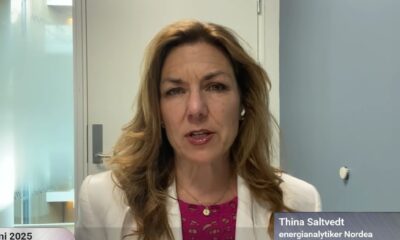
 Nyheter2 veckor sedan
Nyheter2 veckor sedanUppgången i oljepriset planade ut under helgen


